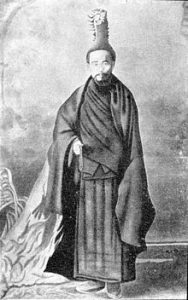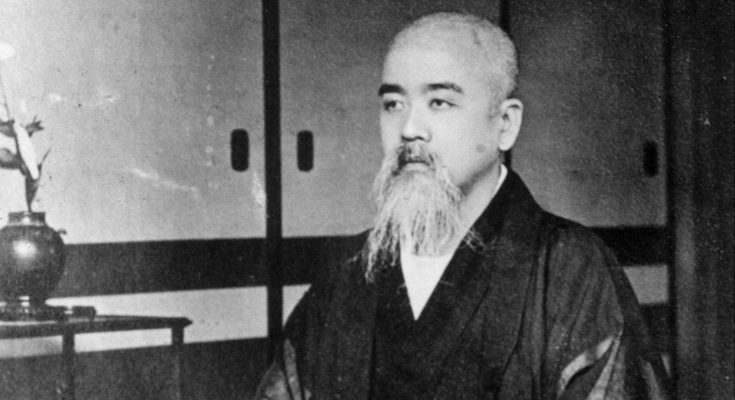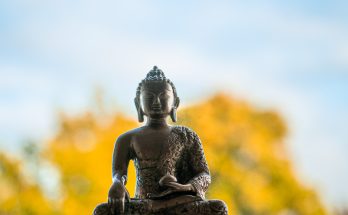Ekai Kawaguchi’s main mission to visit Nepal and sneak into Tibet was to obtain rare Mahayana Buddhist texts. Those who are informed about Kawaguchi believed that he ‘set off on journey of a thousand miles in search of Buddhist scriptures in forbidden Tibet to compare with the Chinese texts he hoped to translate into Japanese’.
Kawaguchi himself wrote:
But I afterwards found that it was not a wise thing to rely upon the Chinese texts alone, without comparing them with Tibetan translations as well as with the original Samskrit texts which are contained in Mahayana Buddhism. The Buddhist Samskrt texts were to be found in Tibet and Nepal. Of course, many of them had been discovered by European Orientalists in Nepal and a few in other parts of India and Japan. But those texts had not yet been found which included the most important manuscripts of which Buddhist scholars were in great want. Then Tibetan translations are superior to the Chinese. As literal translations, I think that they are superior; but, for their general meaning, the Chinese are far better than the Tibetan. Anyhow, it was my idea that I should study the Tibetan language and Tibetan Buddhism, and should try to discover Samskrt manuscripts in Tibet, if any were there available.
-Three years in Tibet.
In the historical perspective, it seems that the arguments is convincing. In the latter half of the nineteenth century and the first half of this century. There were a lot of exploration activities in the Himalayan region. The credit for this naturally goes to the discovery of ancient Buddhist manuscripts, inscriptions, remnants of ancient culture and civilization in the region of which Nepal and Tibet figured prominently. The discovery of the precious Sanskrit Buddhist literature by Brian H. Hodgson, and propagation as well as popularity of the same in the Indian sub-continent and Europe due to the increasing interest in oriental culture and civilisation has opened the eyes of foreign research scholar towards Nepal. The visit of French orientalist scholar Sylvain Levi, Russion orientalist scholar I.P Minaeff, British Professor of Sanskrit Cecil Bendall and other Indologists and scholars of India like Hara Prasad Shastri, Bhagwanlal Indraji who visited Nepal around the same time was an outcome of the growing interest in Nepalese history and culture. But, the purpose of the visit of the above scholars and that of Kawaguchi was different. Kawaguchi ‘s main purpose was to visit Tibet via Nepal and to obtain the Mahayana Buddhist texts in Tibet for translation into Japanese. In his introduction to Three years in Tibet, Kawaguchi wrote that he led a monk’s life after being influenced by the deep study of the collection of Buddhist Mahayana scriptures in Chinese language. After three years of intense study, he came to the conclusion that it was not wise to depend on the Chinese texts without comparing the translation of texts in Tibetan. He was well informed that most of the oriental scholars of the West had discovered the Sanskrit Buddhist texts and were translated into Chinese in Tibet better than in other places. 2 The reason of Kawaguchi ‘s visit to Nepal and Tibet in quest of the better Mahayana texts in Chinese is rather convincing. Therefore, kawaguchi ‘s involvement with the espionage activities might be incidental. Writing on Kawaguchi ‘s physical features, John Snelling wrote:
In pictures taken at the time, Kawaguchi looks every inch the Buddhist priest. In one he poses in a Japanese garden with a rosary playing though his fingers. He head is shaven to billiard ball smoothness, he sports a whispy beard of the Chinese variety and he wears a most splendid, though heterodox, set of robes-they combine elements of the vestments of both the Nichiren and Obaku Zen sect.’
In fact, he was Rector of the Monastery of Gohyakwakan in Tokyo until 1891. Besides this, his writings do not leave a strong ground for suspicion that he was directly or intentionally involved in intelligence activities. The only suspicion is his friendship with Sarat Chandra Das who was on ‘the payroll’ of the British government in India.
Kawaguchi ‘s Three Years in Tibet shows his intimate knowledge of Nepal, specially the intractable Himali areas. During his stay in Nepal he observed the political, economic and cultural condition of Nepal staying in Boudhanath, Mustang and Dolpa. He was probably the first Japanese who entered political Tibet by way of Tsharka in the beginning of the century. 4 ‘It was a very risky journey. On Juy 4,1900, he reached Tibet through a chink in the armour through trackless forests and treacherous glaciers beyond Mt. Dhaulagiri in Nepal. He was saved from being murdered by two Khampas who accompanied him to Mustang. A young woman tried to entice him to make her inn his home too, but in vain 5 Kawaguchi knew the political condition of Nepal. It was because of his knowledge of Nepalese politics that he could please the suspicious Rana rulers with the use of most polite as well as sophisticated language, marked by intelligence and sagacity. He wrote to Rana Prime Minister Chandra Shumshere:
You could establish a great arsenal in interior of the country where your neighbour may not be able to find out what you are doing. With electricity and Japanese engineers (if you are afraid of the friction with your neighbour you may bring them through China with your mission) you may do wonders. My countrymen will do for you anything. Once they put on Nepalese dress and pick up Nepalese language it is hard to find out who they are, so closely they resemble your people as for the army instructors, these could be trained in Japan. Your men may be sent to Japan where they could learn the art thoroughly. 6
According to the same sources, Kawaguchi presided Chandra Shumesher calling him the father of life and liberty, who saved them (the Nepalese) from foreign yoke. This shows that Kawaguchi was well-informed about Nepalese history and culture. Without this knowledge it would simply be difficult to take an incredible hazardous journey into a forbidden land. That a Japanese monk trekked to Dolpa situated at an altitude of 6486 meters on his way to Tibet a century ago from now is indeed incredible. Expressing surprise over this incredible feat, Sharad Pradhan wrote in a paper ‘His perseverance in overcoming the arduous task is remembered as one of the most incredible journey was most memorable as it opened a new horizon in the field of travel.’ 7 Though, any Japanese, according to Pradhan, hardly believed Kawaguchi ‘s nostalgic account of his trip to Tibet, which they thought a superficial one, the significance of his account cannot be undermined. Three years in Tibet led a Japanese ethnographer Dr. Niro Kawakita to trek to Mustang and Dolpa to confirm whether Kawaguchi was true to his word. Kawakita in his article ‘Ethnogeographical observation of the Nepal Himalayas’ came to the conclusion that the monk scholar’s account was true.
 Suspicion of espionage
Suspicion of espionage
There is a lot of controversy whether Ekai Kawaguchi was a spy, or secret agent, of the Japanese government. Kawaguchi entered Lhasa on March 21, 1901, in the guise of a Chinese physician. When Kawaguchi was suspected as a spy, by the Tibetan officials, the Tibetans who helped him were heavily punished. It was also said that he was sent there by the Japanese government to keep an eye on the Russian activities in Tibet. The noted Younghusband mission was there in Lhasa in 1904 to counter-balance the growing Soviet influence in the Tibetan plateau. It may be because of the growing British activity in South Asia that the Tibetans suspected him as a British spy. This suspicion might have been based on Kawaguchi ‘s friendship and secret correspondence with Sarat Chandra Das. Writing in A History of the Thak Khola Valley, Michael Vinding says, ‘The peace which Kawaguchi wnjoyed in Marpha was spoiled by a trader from Tukche who had gone to Calcutta on business and whom Kawaguchi had asked to deliver some letters to Sarat Chandra Das. In Calcutta the Tukche trader learned that Sarat Chandra Das was an employee of the British government, and he therefore concluded that Kawaguchi (whom he thought was Chinese Lama) in reality was a British agent on some secret mission in Nepal Michael Vinding also wrote that ‘while it is unlikely that Kawaguchi was engaged as a spy for the British, he unknowingly might have provided S.C.D as with information of intelligence value.’ 8
One of the strong grounds of suspicion was Kawaguchi ‘s visit to Nepal three times between 1899 to 1905 and his visit to Tibet. The secret and risky journey to remote and forbidden Nepal and Tibet at that time by a Japanese monk is indeed a matter for suspicion. Writing in the Himal magazine Deepak Thapa says, ‘Kawaguchi ‘s repeated incursions into the country led to speculations that he was an agent for his government. In fact, during his second visit in 1902 Chandra Shumshere directly asked the intention of his visit. Kawaguchi somehow managed to impress upon the Prime Minister of his being not more than a humble monk in search of Sanskrit scriptures on Buddhism. 9
Kawaguchi was much disturbed when he was suspected as a spy. Being sad over the suspicion, he lamented in the following poetic lines:
What gnawing torments do I suffer now?
Suspense, distrust and doubts o’erwhelm me.
These melt not or dissolve not from my heart
As yonder snows unmelted, hard to melt.
Those friends of mine, what fate attends them
now?
Tis hard their painful destiny to guess:
Incarcerated and in durance vile
In regions far beyond those snowpeak clouds
I know not how to save them, in despair.
But again:
Should I such means adopt, perversely false,
Subversive of all Truth, dishonest, vile?
To utter falsehoods base would choke my throat;
But still to rescue them resolved am I
To seek for means, untainted by untruth;
To truth, unvarnished, perfect, will I cling.
-Three years in Tibet
Kawaguchi was not simply a learned monk but was a also scholar of great repute. He had contact with learned men of his time like Mrs. Annie Besant, one of the leaders of the Theosophical Society, Anagarika Dharmapala of Sri Lanka, etc. Rabindranath Tagore invited Kawaguchi to Shantiniketan in Calcutta. This friendship culminated in cultural exchanges between Shantiniketan and Japan. He had also contact with Dr. Austine Waddell, British physician and author of The Buddhism of Tibet or Lamaism and Tibetologist Sarat Chandra Das. His friendship with Sarat Chandra Das was long losting. For kawaguchi Sarat Chandra was friend, philosopher and guide, Sarat Chandra taught him the Tibetan language and manners, Scoot Berry wrote, Perhaps because he himself suffered the hardships of travel so acutely, it was difficult for Das to imagine the frail-looking little monk surviving at all.. At any rate, he never abandoned his efforts to dissuade his Japanese student, and long afterwards a letter from Das to Kawaguchi a last-ditch attempt to convince him to give up which reached him in the Nepali town of Marpha, would have the ironic effect of forcing the wavering monk into decision to continue. 10 Kawaguchi met Anagarika Dharmapala of Sri Lanka in Bodhgaya, India. He was influenced by Dharmapala. Mrs. Annie Besant advised him to publish. Three years in Tibet.
Scoot Berry gave a brief biographical account of Kawaguchi. Kawaguchi ‘s father had a reputation for honesty and hard work and was deeply religious in an uncritical and unquestioning way characteristic of simple hard-working people. Kawaguchi was self-educated. At the age of 15 he had read the life of the Buddha. Inspired by it he turned to vegetarianism, celibacy and abstinence for alcohol. Since his adulthood he was attracted towards enunciation.
Looking at this biographical account and his dedication to pursue the path of knowledge and learning, and his indifference to wealth and material prosperity, it is hard to believe that he was involved in intelligence activity for the selfish ends.
References
- Lall. Kesar, 1992. Nepal A Miscellany. Kathmandu : Ratna Pustak Bhandar.
- Kawaguchi ‘s visit to Nepal ( Nepal translation) by Tanka Bilas Varya. Kathmandu : Japanese Literature Translation Publication, 1989.
- Snelling, John, 1973. The Sacred Mountain; London : East-West Publications.
- Snellgrove, David 1958. Himalayan Pilgrimage: Oxford : Burno Cassirer.
- Lall, Kesar, 1992
- Thapa, Deepak, 1993. Sleuth, Monk and Consultant. Himal, July-Aug. 1993
- Pradhan, Sharad, 1993, Dolpa the Dreamland of Japanese. The Kathmandu Post. October 17, 1993.
- Thapa, Deepak, Himal.
- Berry, Scoot, 1990. A stranger in Tibet : The adventures of a Zen monk. London : Collins in association with Kodansha International Ltd.
Death od Sanghanayaka
Tansen, Palpa, Oct.24-The last rites of Snghanayaka (Head of the Sangha) Bhikshu Shakyananda Mahasthavira were performed here following the Buddhist tradition. He died here yesterday. He was 87. he was suffering from asthma since a pretty ling tome. His body was kept at Ananda Vihara at Tansen for the public view.
A function was also organized here to pay tribute to late Shakyananda Mahasthavira. Speaking on the occasion Chairman of All Nepal Bhikshu Mahasangha Bhikshu Kumar Kashyap said that late Shakyananda had contributed a lot in the promotion of Theravada Buddhism in modern Nepal.
Ambassador of Myanmar to Nepal expressed shock at the death of Shakyananda and added that his country had honoured the departed monk with special decoration in recognition of his paintaking labour and sacrifice.
Also, the condolence message of Ambassador of Sri Lanka was also read out on the occasion.
The function was attended by Bhikshu Sudarshan Mahasthavira and Deputy Sanghanayaka Anirudra Mahasthavira.
Meanwhile, Prime Minister Surya Bahadur Thapa, in his condolence message, said that he was shocked to hear the death of Shakyananda.
Similarly, President of Nepali Congress and ex-Prime Minister Girija Prasad Koirala expressed condolence at the death of the senior most monk.
Chairman of CPN-UML Manmohan Adhikari paying his tribute to late Shakyananda Mahasthavira said that he was shocked to hear the news of the passing away of Shakyananda.
Late Shakyananda Mahasthavira was born at Taksar locally in Bhojpur district of Nepal in 1910. he had the education of a Sramanera in Benares in 1932 and he was ordained in Myanmar (then Burma ) in 1935. He had learnt Pali and Buddhist philosophy in Myanmar. He had propagated Buddhism traveling different parts of Nepal.
He was conferred special prestigious decorationby the government of Myanmar in May this year. He had also written several books on Buddhism.
Ashoka pillars in state of neglect
Kapilvastu, Oct 26- The Ashoka pillars in Niglihawa VDC and Gotihawa VDC are in a state of neglect and proper security measures are lacking.
The Ashoka pillar at Niglihawa VDC some six km from the district headquarters of Taulihawa was installed by the Maurya emperor Ashoka.
The pillar is now in two pieces with the longer piece lying on the ground.
Inscription on the pillar says that it was installed with formal rituals by Ashoka in the 20 th year of his ascent to the throne.
Similarly, three pieces from the Ashoka pillar at Gothihawa VDC some four kilometers from Taulihawa are now at Kapilavastu Museum while the long portion is embedded in the ground at Gotihawa.
Finishing from Mauryan times is still visible on the upper part of the pillar.
The pillar was built by Emperor Ashoka in memory of Krakuchanda Buddha.
The sites of the two pillars are now in great neglect and are being used by local people for grazing cattle, farming and dyeing.
The pillar at Gotihawa become more than half submerged in water. The barbed wire installed for security has been broken and the need is felt for attention by the authorities concerned to the overall security arrangements.
Historical objects Hidden beneath Tilaurakot
Kathmandu, Oct. 4- Archaeological geophysical survey work carried out in the Tilaurakot and Ramgram area has indicated that more archaeological objects associated with Lord Gautam Buddha are buried under the surface.
The ultra modern scientific survey work was carried out for the first time in Nepal under the joint auspices of the Department of Archaeology, the Lumbini Development Trust, UNESCO and the World Heritage Centre.
The survey shows ruins and vestigial pathways lying buried beneath the ground.
The new technology requires no excavation work, and objects under the ground can be surveyed by computer placed above ground and with the use of earth registration measurement and magnetometer measurement equipment.
According to Deputy Director General of Archaeology Department Mrs. Riddi Pradhan, the survey was carried out at Ramgram because the sacred relics of Lord Buddha were placed in a stupa built there for the purpose.
The convenor of the survey carried out from Sept. 5 to 24 was chief archaeological officer at the Archaeology Department Kosh Prasad Acharya while Dr Robin Cunningham, an archaeologist from Bradford University in the U.K, led a team sent by UNESCO.
The seven member team includes Chandra Prasad Tripathi and Shukra Sagar Shrestha from the Archaeology Department and Basant Bidari from Lumbini Development Trust.
After the Buddha’s Nirvana, his sacred relics were divided into eight parts and one part was given to his mother’s blood family. This was placed in the stupa built at Ramgram.
All the other seven stupas housing the sacred relics were later opened by Emperor Ashoka and only the one at Ramgram remains intact.
UNESCO and the World Heritage Centre sent its survey team to Nepal following a request by His Majesty’s Government to include Ramgram and the Kapilavastu Area in the World Heritage List.
The new survey technology which can probe down to a depth of two meters has been used as conventional excavations tend to damage the archaeological objects being sought, Dr. Cunningham said.




